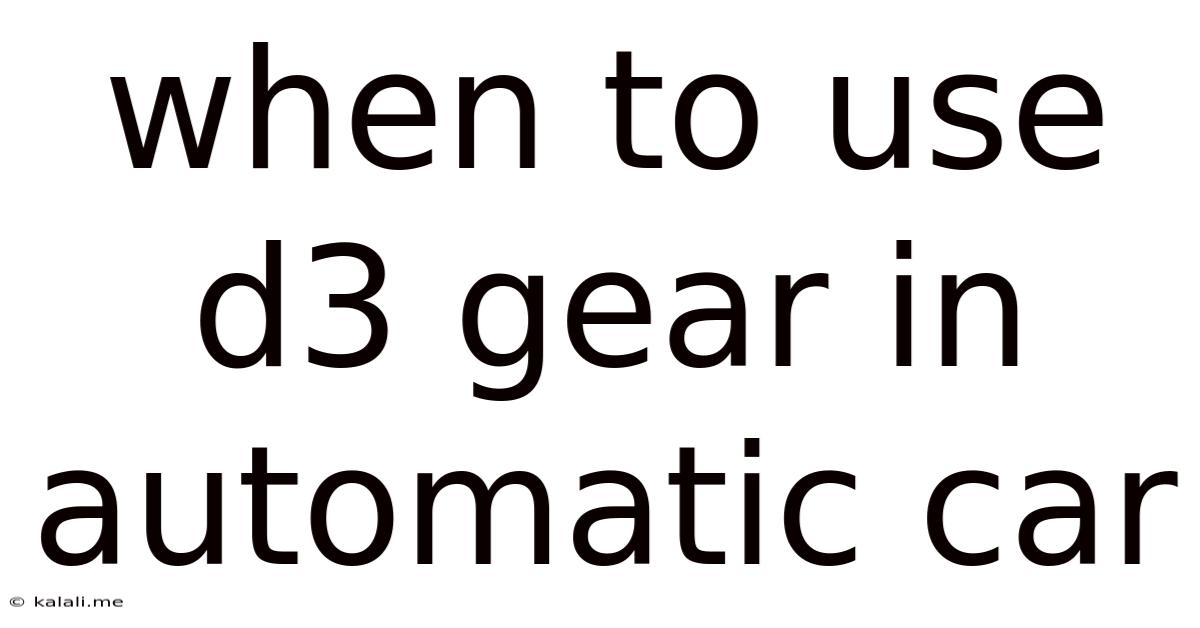When To Use D3 Gear In Automatic Car
Kalali
Jun 10, 2025 · 3 min read

Table of Contents
When to Use D3 Gear in an Automatic Car: A Comprehensive Guide
Many drivers of automatic cars are familiar with the different gear positions – Park (P), Reverse (R), Neutral (N), and Drive (D). However, some automatics also include a D3 gear setting, leaving many wondering when and why they should use it. This article will explore the purpose of D3, its advantages and disadvantages, and when it's most appropriate to engage this lower gear setting in your automatic vehicle.
What is D3 Gear?
D3, or third gear, is a lower gear setting found in some automatic transmissions. Unlike Drive (D), which allows the car to automatically shift through all gears, D3 limits the transmission to only using first, second, and third gears. This means the car won't shift into overdrive or higher gears, resulting in more engine braking and increased engine power at lower speeds.
When Should You Use D3 Gear?
The optimal time to use D3 is in situations that require more engine braking and control, especially on steep inclines or declines. Here are some specific scenarios where D3 can be beneficial:
-
Descending Steep Hills: D3 provides significant engine braking, helping to control your speed and reduce reliance on your brakes. This is crucial for safety and preventing brake overheating, particularly on long, steep descents. This helps maintain control, especially when descending for extended periods.
-
Towing or Hauling Heavy Loads: When towing a trailer or carrying a heavy load, D3 can help maintain momentum and prevent the transmission from hunting between gears, ensuring smoother acceleration and better control, especially during uphill driving.
-
Driving in Mountainous Terrain: Similar to descending steep hills, D3 is advantageous in mountainous regions with winding roads and significant elevation changes. The increased engine braking enhances control and safety.
-
Engine Braking for Better Control: In situations requiring more control, like navigating slippery roads or tight turns, D3 can provide extra engine braking, improving stability and maneuverability. It's particularly helpful in low traction conditions.
Advantages of Using D3 Gear:
- Increased Engine Braking: This is the primary advantage, enhancing vehicle control, particularly during descents.
- Improved Control on Hills: Provides better hill-climbing ability and descent control.
- Enhanced Stability: Better stability and handling in challenging driving conditions.
- Reduced Brake Wear: Less reliance on brakes reduces wear and tear.
Disadvantages of Using D3 Gear:
- Lower Fuel Efficiency: Operating at lower gears generally consumes more fuel.
- Reduced Top Speed: The car will not reach its top speed while in D3.
- Potential for Increased Engine Wear: While generally not a significant concern, constant use of lower gears can put additional strain on the engine.
When NOT to Use D3 Gear:
- Normal Driving Conditions: For everyday driving on flat roads and highways, D is generally sufficient and more fuel-efficient.
- High-Speed Driving: D3 is not suitable for high-speed driving on freeways or open roads; it will significantly reduce your top speed.
Conclusion:
D3 gear is a valuable tool for specific driving situations, primarily when increased engine braking and control are necessary. However, it's crucial to understand its limitations and use it appropriately. For everyday driving, utilizing the standard 'D' setting remains the most efficient and effective option. Remembering when to engage D3, and when to avoid it, ensures a safer and more controlled driving experience, particularly in challenging road conditions.
Latest Posts
Latest Posts
-
How Many Ounces Are In 9 Pounds
Jul 01, 2025
-
What Kind Of Room Has No Doors Or Windows
Jul 01, 2025
-
How Many Cups Of Elbow Macaroni Are In A Pound
Jul 01, 2025
-
How Many Guppies In A 5 Gallon Tank
Jul 01, 2025
-
How To Beat Stage 7 In Bloxorz
Jul 01, 2025
Related Post
Thank you for visiting our website which covers about When To Use D3 Gear In Automatic Car . We hope the information provided has been useful to you. Feel free to contact us if you have any questions or need further assistance. See you next time and don't miss to bookmark.